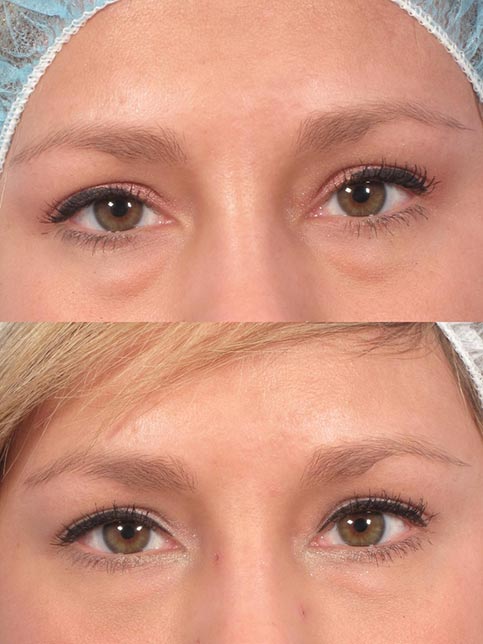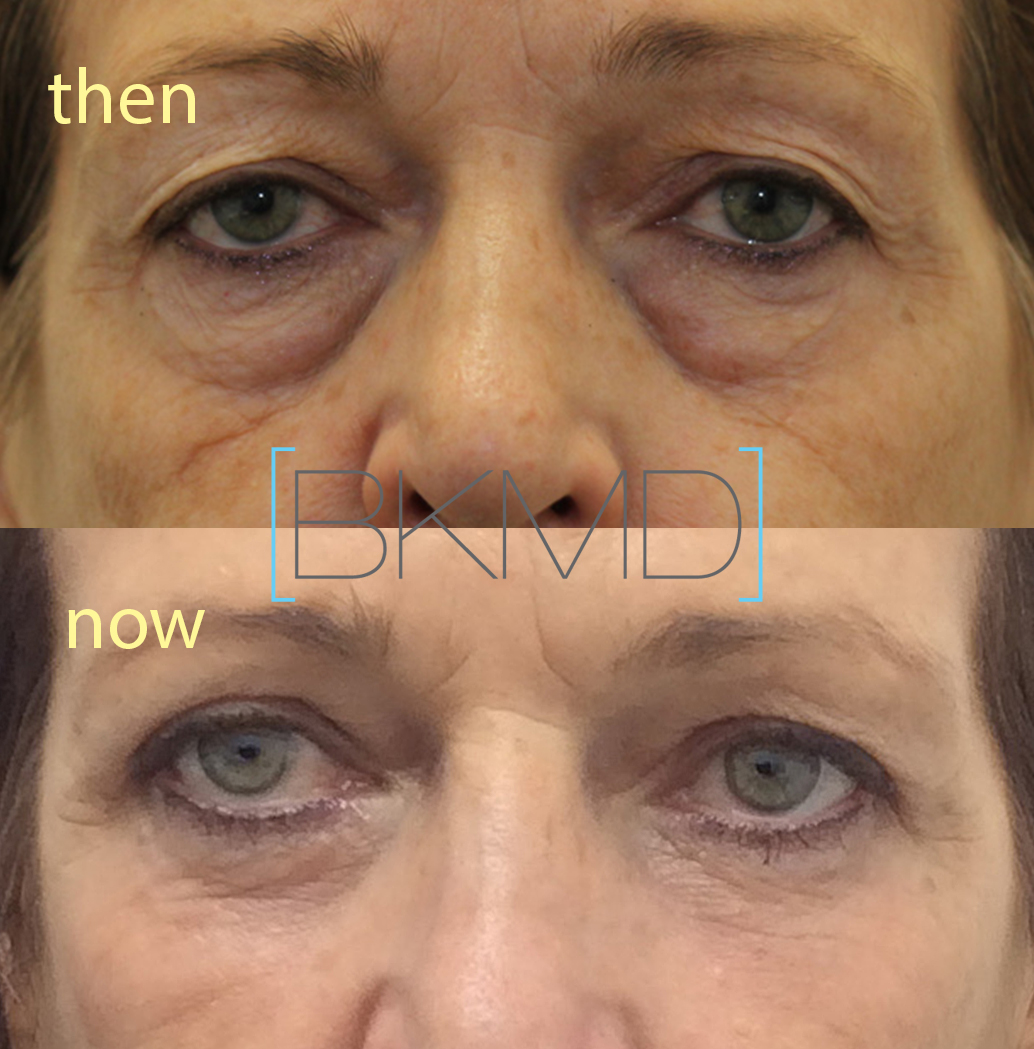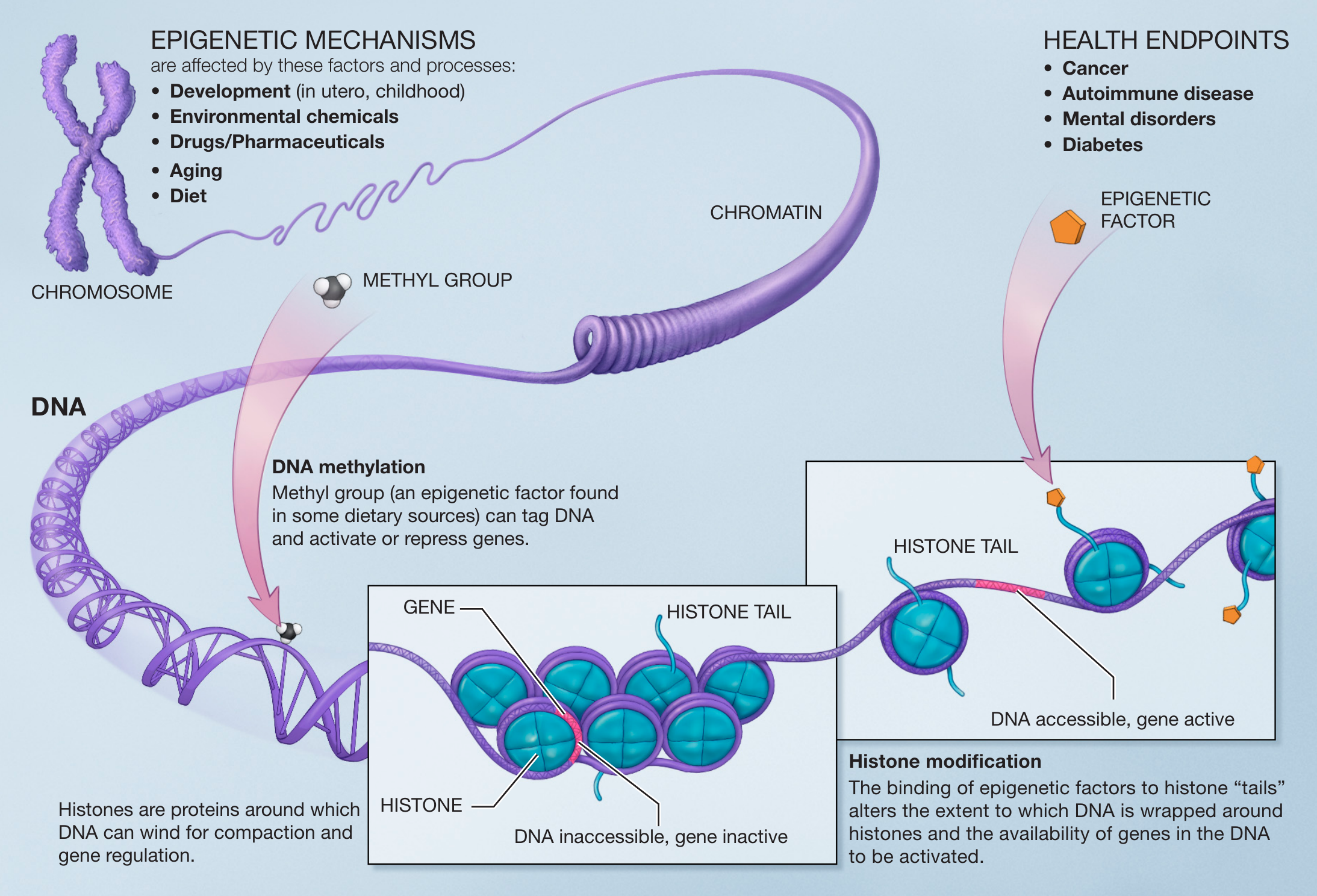Here are some burning questions you may have about eye bags and sagging eyelids:
Are eye bags hereditary and is there a gene for eye bags?
Will I have have the same dark circles or sagging eyelids as my parent or sibiling?
Does our current scientific understanding offer anything for me to stop the above from happening?
If you’ve ever caught a reflection of your eyes in the mirror and felt like you are starting to look like your parent, this article is for you. Or if you’ve looked at your parent’s eyes and thought to yourself, “are those bags and droopy lids going to happen to me?” then keep reading.

“Hereditary” eye bags in a 20-year-old before and after treatment
Chances are, left to their natural progression, your eyes will in some way resemble your parent’s eyes when you arrive at their age.
Unless you do something.
But what is that something that will help you change course without looking strange or simply wasting money on things that don’t work?
Firstly, what does current science say about how your genetics influence the look of your eyes and how much of your eye bags are hereditary?
Here are the 2 things you should know right away.
- The vast majority of eye bags have a significant hereditary component.
This means if one or both of your parents or your sibling has eye bags or sagging eyelids there is a decent chance that you have them or will develop them as well.
- There is no single gene for eye bags.
This means that the appearance of your eyelids is a polygenic trait. Multiple genes influence eye bags and sagging eyelids unlike blood type for example that is determined by a single gene and transmitted by Mendelian inheritance patterns.
What are the current theories about why eye bags occur?
Eye bags are likely caused by an intersection of several processes, influenced in part by your genetic code.
One commonly held theory is that eye bags are comprised of normal under-eye fat in normal amounts but the fat herniates or pushes forward due to a lack of support from the tissues in front of the fat. These tissues include the orbital septum, the orbicularis muscle, the skin, and the layers of connective tissue in between these. I think this theory is mostly untrue. The septal layer for example is so thin it doesn’t really act like a support structure. While relaxation of these layers may be a sign of aging they are not likely the primary cause of bags.
Another theory describes the homeostasis of the fat cell regeneration and recycling. The stem cells or progenitor cells in the under-eye fat create new fat while the preprogrammed cell death within these cells (apoptosis) reduces the amount of fat. Bags may appear when there is more fat cell population numbers than there is clearance of older fat cells. Or the existing cells can enlarge while the population number stays the same.
Other theories explain that volume and tissue loss that occurs with normal aging leads to an uncovering of the eye bags that were blended with younger age due to the upper cheek fat and the insulation layer of fat that occurs under the skin (also uncovered by the loss of bone along the orbital rim and inside the orbit). When the fullness around the bags disappears, the bags become more noticeable. This may be multiplied in appearance when combined with fat growth (see preceding theory).
The genetic factors for eyelid sagging can include your skin type, the amount of collagen and elastin your body has created in this area, and other growth factors including TGIF1.
Now for the deeper science…
How are eye bags and sagging eyelids specifically influenced by genetics?
One of the strongest indicators of genetic influence on sagging eyelids was shown in 2 population cohorts of Eastern Europeans by Jacobs LC and colleagues in JAMA Dermatology journal in 2014. They showed that the heritability of sagging eyelids was 61% among a group of 1052 twin pairs and single allele near TGIF1, also know to be a skin aging determinant was major influence in sagging eyelids (dermatochalasis is the medical term for sagging eyelids). The SNP (single nucleotide polymorphism) locus (you can use this to determine if you are prone to sagging eyelids using a genetic screening service) is the C or G allele of rs11876749. This means there are commercial DNA services like 23 and Me that provide you with raw SNP data from your own genome and you can reference your results in a database that will tell you if you have the eyelid sagging influencing gene.
2 other SNPs were identified in 2019 by Laville V and colleagues as reported in Experimental Dermatology journal. They looked at 502 Caucasian women in Paris and found an association with 2 chromosome 10 regions, rs16927253 and rs4746957 and a “protective effect” against eyelid sagging.
Regarding prominent lower eyelid fat pads, no responsible genes or SNP’s have yet been identified as having influence. One study performed by Stacy RC and colleagues in 2014 and published in Histopathology journal aimed to see if herniated lower eyelid fat was a reactive process (caused by something in the environment) versus out-of-control fat cell growth. Genetic studies (array comparative genomic hybridization or aCGH) did not show any genome-wide copy alterations.
In 2018 a group of researchers (Endo C et al) found a quantitative trait locus (QTL) at rs12570134 associated with EMX2 expression that influenced the appearance of double eyelids (the presence of a well-formed upper eyelid crease) in Japanese women.
Epigenetics and how your diet affects your offspring
A long time ago (like when I studied genetics in graduate school) the standard teachings were that the way we look was influenced by nurture (the environment) and nature (our genetic code). Some combination of these two would give us our resultant appearance. But we now know that there is an interaction between nature and nurture.
Epigenetics refers to inheritable changes in the expression of our genes that is not due to the coding of our DNA. If it’s not in the blueprint but it can be passed along to our offspring where do these changes come from?
Mechanisms like DNA methylation for example can change how our blueprint is used. Molecules called methyl groups can attach to DNA strands and silence genes that make important proteins or silence suppressor genes that keep other genes in check. DNA methylation is influenced by diet and environmental exposures.
Here is a visual overview of how epigenetics are thought to work (courtesy of Wikipedia):
So, the way you eat and the things you do can not only affect you but your children on the genetic level. Epigenetics can come into play with your facial features including eye bags.
We know that retinol creams work on the skin cell’s genetic level and can affect methylation and modify histones that influence stem cell differentiation. In short, it’s conceivable that using topical creams like retinols (vitamin A derivatives) and ascorbic acid (vitamin C) can induce heritable changes in DNA transcription that have implications in skin health and appearance.
The genetics of aging as it relates to eyelids
Another aspect of genetic influence on eye bags and sagging eyelids entails the way that our genes affect aging changes in our cells. Our stem cells or progenitor cells have multipotential to become different structures in our body. Stem cells are required to regenerate populations of specialized cells that decline when they are damaged or have deteriorated. As we age our stem cells become less efficient and their numbers dwindle due to several mechanisms. Some proposed reasons are shortening of telomeres and DNA damage from extrinsic forces. Epigenetic factors can also play a role in age-related stem cell downregulation.
So our cells are both pre-programmed to age and they age from outside stressors. And this certainly affects the way we look.
One sign of aging around the eyes is bone loss and decreased bone density. This causes the bony socket around the eyes to become larger which in turn leads to a more sunken eyelid appearance and looser appearing eyelid skin. This phenomenon can also make the outline of the eye bags look more obvious.
Our genes affect the skin of the eyelids including the skin color (and your level of susceptibility to UV damage), your production of structural skin components like collagen, elastin, keratin, and extracellular matrix proteins. Even the genes regulating hormone production affect skin aging and appearance.
Between skin and bone are connective tissue and muscular structures that are also subject to aging changes seen both in size and composition. Degradation of ligamentous structures can translate into laxity of the eyelids and a sagging appearance as support is lost.
Can you outsmart your genes to avoid eye bags and loose eyelid skin?
The short answer is yes and no.
There are currently no targeted gene therapies that modify eyelid appearance associated genes even if you can characterize some of them through consumer or medical genetic testing.
You can modify your diet and behavior to reduce the risk of adverse epigenetic events and to increase the chance of an advantageous aging process. Some of the obvious ways to do this are avoidance of long periods of sun exposure with UV-protective sunglasses and sunscreen, avoidance of smoke, and eating a healthy diet (and perhaps foods that have been suggested as improving the epigenetic milieu).
You can use topical agents like retinols that improve skin thickness, l-ascorbic acid that reduces (and reverses) oxidative damage.
What are the treatments for hereditary eye bags and sagging eyelid skin?
Let’s assume you have a gene that is associated with droopy upper eyelid skin or hereditary eye bags that your parent and grandparent also have. How are these treated if we don’t have targeted gene therapy? The treatment for loose upper eyelid skin and eyelid bags are generally the same regardless if they are from environmental exposures (such as a history of excessive sunbathing in your 20’s) or from genetic tendencies.
For sagging upper eyelids the best treatments are Dysport or Botox when the issue is very mild, laser tightening if you have the right skin type and the issue is mild to moderate, and upper eyelid blepharoplasty surgery when the issue is moderate to severe. Click this link to see photos of upper eyelid treatment results.
For lower eyelid bags, sagging, and dark circles the most mild treatment would be concealers or temporary skin tightening creams and more advanced would be fillers and/or laser. The most definitive treatment involves lower eyelid surgery that can include fat reshaping or removal, skin resurfacing or removal, and potential fat grafting. You can see some photos of these treatment results here.
Before and after upper and lower eyelid blepharoplasty surgery for sagging skin and eye bags:

We are just getting started
If you think your eyelid aging is caused by your DNA you are probably mostly right. Since you can’t choose your parents and you can’t treat your genes (yet) you’ll have to stick with traditional treatments for now. We are still just learning about the genetics of eyelid morphology and aging and eventually there may be a curative eyebag pill or shot.
Most people who seek my assistance with the appearance of their eyelids attribute their concerns to hereditary causes. While this does factor into my evaluation and treatment plan, the offerings are largely the same if you have a “genetic” cause or a “lifestyle” cause. The recommended course of action to get started is to have an evaluation by an oculoplastic surgeon whose practice significantly entails cosmetic eyelid procedures.
References
JAMA Dermatol. 2014 Aug;150(8):836-43. doi: 10.1001/jamadermatol.2014.27. Intrinsic and extrinsic risk factors for sagging eyelids. Jacobs LC, Liu F, Bleyen I, et al.
Exp Dermatol. 2019 Aug;28(8):892-898. doi: 10.1111/exd.13559. Epub 2018 Jun 28. A genome wide association study identifies new genes potentially associated with eyelid sagging. Laville V, Le Clerc S, Ezzedine K.
Histopathology. 2014 Aug;65(2):273-7. doi: 10.1111/his.12404. Epub 2014 Apr 17. Absence of chromosomal abnormalities in herniated orbital fat. Stacy RC, Bernardo LA, Nielsen GP.
Sci Rep. 2018 Jun 12;8(1):8974. doi: 10.1038/s41598-018-27145-2. Genome-wide association study in Japanese females identifies fifteen novel skin-related trait associations. Endo C, Johnson TA, Morino R, et al.
J Cell Physiol. 2014 Jul;229(7):825-33. doi: 10.1002/jcp.24522. Epigenetics and Ocular Diseases: From Basic Biology to Clinical Study. Biao Yan, Jin Yao, Zhi-Fu Tao, Qin Jiang
Arq Bras Oftalmol Sep-Oct 2015;78(5):328-31. doi: 10.5935/0004-2749.20150087. Eyelid Aging: Pathophysiology and Clinical Management. Renato Wendell Damasceno, Georgia Avgitidou, Rubens Belfort Jr.
Interesting links
Here are some interesting links for you! Enjoy your stay :)Pages
- 5 Steps to Looking Younger
- About
- After Botox/Dysport: “Spock Brow”/Over-arched Brow
- Asian Double Eyelid Lift Surgery in NYC
- Asymmetric Eyelids
- Before and After Portfolio
- Before/After Cosmetic Oculoplastic Surgery
- Blepharoplasty in NYC with an oculoplastic surgeon
- Books
- Botox and Dysport in NYC with an oculoplastic surgeon
- Botox/Dysport/Xeomin
- Brow Lift
- Brow lifts
- Brow Ptosis
- Cannula Tear Trough Under-Eye Filler best for Eye Bags NYC
- Canthopexy and Canthoplasty
- Cheek Redefining
- Chemosis
- consent- biopsy
- consent- blepharoplasty
- consent- brow lift
- consent- chalazion
- consent- cosmetic injection
- consent- double eyelid
- consent- eyelid ptosis
- consent- facelift
- consent- facial implant
- consent- filler dissolving enzyme
- consent- laser or chemical skin peel
- consent- liposuction
- consent- pronox
- consent- revision surgery
- consent- sculptra
- consent- surgery chaperone
- consent- thread lift
- Contact
- Cosmetic Eyelid Surgery Guide
- COVID-19 Measures
- Crow’s Feet
- Dark Circles and Eye Bags
- Double Eyelid Surgery Guide
- Dr. Kotlus Blog
- Droopy Eyelid Ptosis Surgery
- Eye Bags and Dark Circles Treatments
- Eyebrows
- Eyelid Conditions
- Eyelid Procedure Affects
- Eyelid Ptosis Repair
- Eyelid Retraction
- Eyelid Revision Surgery
- Eyelid Skin Fat Deposits
- Eyelid Veins
- Facials
- Fat Transfer, Fat Grafting
- Festoons
- Festoons and Malar Bags
- Glabellar Furrows
- Hollow Under-Eyes
- Home: Dr. Kotlus NYC Oculoplastic Surgeon | Blepharoplasty | Eye fillers
- Lacrimal Gland Prolapse
- Lateral Canthal Blunting
- Lateral Canthal Rounding
- Lectures and Presentations
- Lid Ptosis
- Lip Enhancement
- Liposuction
- Loose Lower Eyelid Skin
- Loss of Eyelid Skin Pigment
- Lower Blepharoplasty (Lower Eyelid Lift)
- Lower Eyelid Bags
- Lower Eyelid Conditions
- Lower Eyelid Fat Pad Reduction/Repositioning
- Lower Eyelid Skin Pinch
- Lower Eyelid Skin Resurfacing
- Lumps/Irregularities
- Necklift and Facelift NYC
- Nose
- Orbicularis Oculi Muscle Tightening
- Other Eyelid Concerns
- Patient Forms
- Patient Reviews
- Pause and Reverse: How to Look Younger Than Your Age With or Without Cosmetic Surgery
- PDO Thread Lift NYC
- Privacy Policy
- Procedures
- Research and Publications
- Residual Fat After Blepharoplasty
- Soof Lift
- Superior Sulcus
- Tame Your Eye Bags and Dark Circles
- Thank you for requesting your NY Thread Lift Consultation
- Transverse Brow Furrows
- Treatment of Chemosis
- Treatment: Lacrimal Gland Suspension (Sagging Tear Gland)
- Treatment: Botox “Spock Brow”
- Treatment: Eyelid Droop After Botulinum Toxin (Botox, Dysport, Xeomin)
- Treatment: Eyelids
- Treatment: Fat Pouches After Eyelid Lift
- Treatment: Festoons
- Treatment: Lower Eyelid Retraction
- Treatment: Lumps After Fillers
- Treatment: Superior Sulcus (Upper Eyelid Hollowing)
- Treatment: Tyndall Effect
- Treatments: Brow
- Treatments: Brow and Forehead Wrinkles
- Treatments: Crow’s Feet
- Treatments: Hollow Lower Eyelid/Tear Trough
- Treatments: Lower Eyelids
- Treatments: Under-Eye Dark Circles
- Treatments: Upper Eyelid
- Tyndall Effect: Blue Discoloration After Hyaluronic Filler
- Under-Eye Dark Circles
- Upper Blepharoplasty (Upper Eyelid Lift)
- Upper Dermatochalasis
- Upper East Side Manhattan Location | NYC Cosmetic Eyelid Plastic Surgeon
- Upper Eyelid Conditions
- Upper Eyelid Lift NYC
- Upper Eyelid Treatments
- Upper Steatoblepharon
- Wrinkle Treatment Fillers | Botox | Laser | Microneedling NY
- Younger Podcast: Expert Advice on How to Look Younger and Live Longer
- 雙眼皮手術頁

